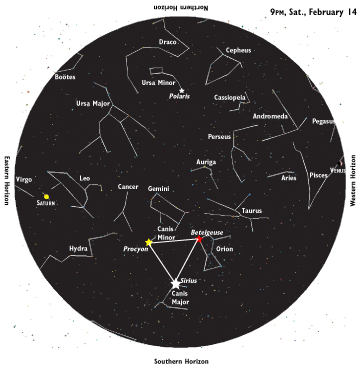
|
Volume XVII, Issue 7 - February 12 - February 18, 2009
|
|
Columns Reviews |
 |
Sky Watch by J. Alex Knoll
Winter’s Triangle of Lights
Three of the 10 brightest stars travel together
he sun sets around 5:40 at week’s end and lingers more than a minute later each evening. As the sky darkens, the first celestial object you’re likely to see is the evening star Venus high in the west-southwest. With the moon rising in late evening then early morning this week, Venus is the brightest object visible in the night sky until it sets a little after 9pm.
While Venus commands western skies, Saturn, which rises around 8pm, dominates the east, flanked by the not-quite-so-bright stars Regulus to the west and Spica to the east. As dawn approaches, around 7am this week, Saturn remains high overhead in the west.
Before daybreak, three early morning planets climb above the southeast horizon. Mercury appears first, around 6am, as a steady light brighter than any surrounding stars. About 30 minutes later, Mars crests the horizon, a dim, orange-red smudge compared to bright Mercury. Jupiter rises fast on Mars’ heels and dominates the sky for the next half-hour before sunrise. Keep an eye on this patch of sky over the next few weeks as these three planets move closer together in pre-dawn skies.
Sirius, the brightest of all stars, is high in the southeast at nightfall. Part of the constellation Canis Major, the great dog, Sirius is our fifth-closest stellar neighbor at a distance of 81⁄2 light years. Procyon, the eighth-brightest star, shines above Sirius in the constellation Canis Minor, the little dog. Both trail behind their master, the great hunter Orion. The red-giant marking Orion’s shoulder, Betelgeuse is the 10th-brightest star, and combined with Sirius and Procyon it forms the asterism called the Winter Triangle.
Illustration: © Copyright 1925 M.C. Escher/Cordon Art-Baarn-Holland; Graphics: © Copyright 2009 Pacific Publishers. Reprinted by permission from the Tidelog graphic almanac. Bound copies of the annual Tidelog for Chesapeake Bay are $14.95 ppd. from Pacific Publishers, Box 480, Bolinas, CA 94924. Phone 415-868-2909. Weather affects tides. This information is believed to be reliable but no guarantee of accuracy is made by Bay Weekly or Pacific Publishers. The actual layout of Tidelog differs from that used in Bay Weekly. Tidelog graphics are repositioned to reflect Bay Weekly’s distribution cycle.Tides are based on National Oceanic and Atmospheric Administration and are positioned to coincide with high and low tides of Tidelog.
